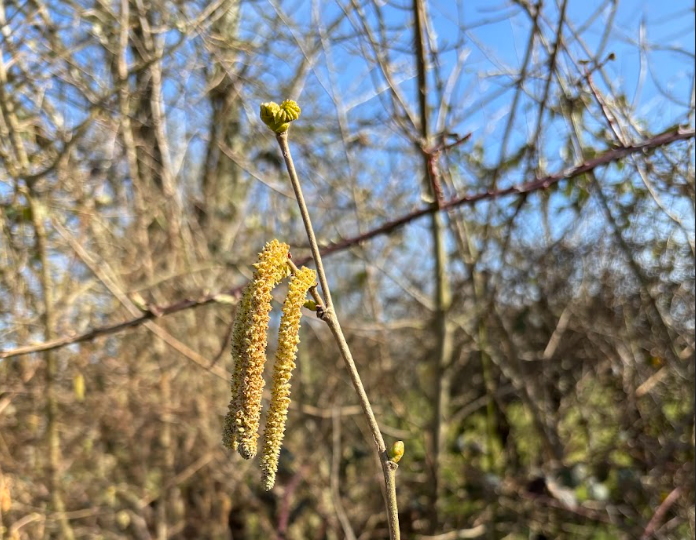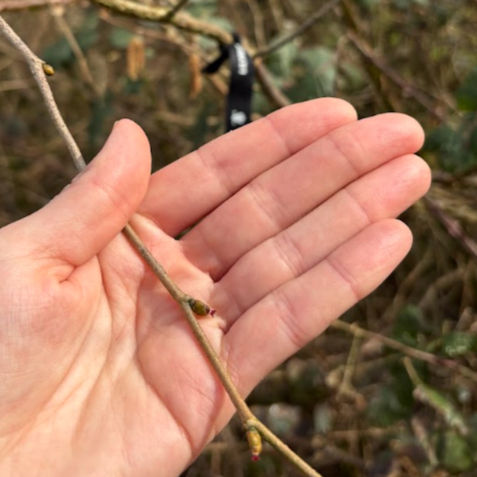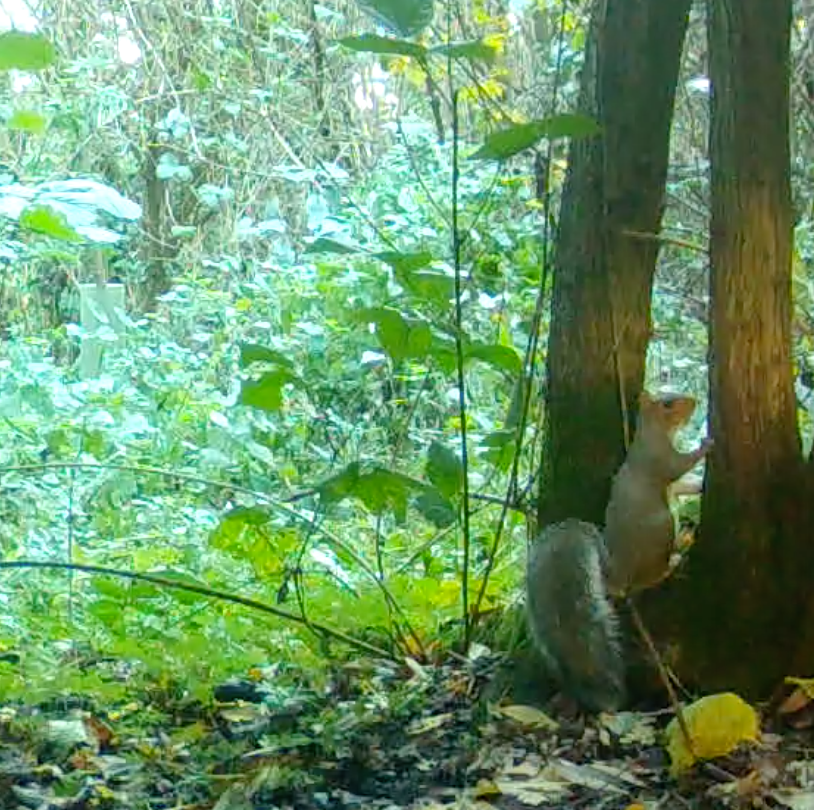Hazel: A Native British Tree
- Jane Orton
- 5 days ago
- 5 min read
Hazel trees are a feature of European folklore, a haven for wildlife, and a food source for humans. Dr. Orton introduces one of Britain’s most fascinating native trees!

Also known by its Latin name corylus avellana, hazel is one of Britain’s most iconic native trees: one of the first to colonise Britain after the last ice age! Hazel is easily recognisable even in winter, as trees often have multiple trunks growing in clusters. You’ll see that the bark is smooth and grey-brown, peeling, roughening and darkening with age. Hazel trees can grow over ten metres tall.
As early as December – or at least from mid-February – long, tail-like catkins hang from the branches. These are the male flowers, and will release pollen which is distributed by the wind to fertilise other hazel trees.
Hazel is monoecious, meaning that both male and female flowers are found on the same tree. Female flowers will appear from January-April and are tiny and bud-like with red styles (the part of a flower that connects the ovary to the stigma, or receptacle for pollen). These flowers will receive pollen from the catkins of other hazel trees and develop into oval fruits in groups of one to four. In the late summer, these will mature into hazelnuts enclosed in a leafy husk.
From May, leaves will appear on the tree. Hazel leaf buds are oval, blunt and hairy. When fully grown, leaves are rounded or oval, with a slightly heart-shaped base, doubly toothed pointed at the tip. Leaves are soft to the touch due to the downy hairs on their underside and have bendy, hairy stems. Enjoy their display of yellow before they fall in the autumn!
Hazel Tree Folklore
Hazels have an important place in British and Northern European folklore. Hazel rods were thought to protect against evil spirits in England and Northern Europe, sometimes being used as burial rods in Medieval England. In Celtic folklore, hazels are associated with wisdom.
Hazel is also recommended in folklore for wands and for water-divining. In some parts of England, plant lore holds that hazelnuts were carried as charms and thought to protect from rheumatism.
Hazel Trees and British Wildlife
All of our native trees are beneficial to wildlife, but hazel is particularly good for moths. Its leaves provide food for the caterpillars of large emerald, small white wave, barred umber and nut-tree tussock moths. Hazel is also associated with the fiery milkcap fungus, which often grows in the soil beneath it.

Hazel trees are beneficial for one of our rarest mammals, the hazel dormouse, which eats both the hazelnuts and the caterpillars that feed on its leaves. Hazelnuts also provide food for woodpeckers, nuthatches, tits, wood pigeons and jays and small mammals.
Humans and Hazels
Humans have many uses for hazel – and this can sometimes benefit other wildlife, too!
Hazel wood can be twisted or knotted and has historically been used by humans for making furniture, as well as thatching spars (used to secure layers of thatch to roofs), net stakes, water-divining sticks and hurdles. Today, hazel is popular with gardeners for use as pea sticks and bean poles. These activities are made possible through the process of coppicing (cutting the wood at ground level process of coppicing (cutting the wood at ground level). Cut hazel in winter for longer-lasting products!
Like some of our other native trees, hazel will produce new shoots from dormant buds around the wound, which humans utilised to harvest wood through coppicing. Usually, hazel trees can live for up to 80 years, but if coppiced, this can be extended to several hundred years.

Coppicing creates cycle of cutting and growth that allows light to reach the woodland floor, prompting a brief flourishing of plant life that feed invertebrates, particularly butterflies. The Heath Fritillary, now one of our rarest butterflies, is nicknamed “the Woodman's Follower” as it is associated with coppiced woodland.
The Woodland Trust says that coppiced hazel also provides shelter for ground-nesting birds like nightingales, nightjars, yellowhammers and willow warblers.
Hazel is also a popular hedging plant. While humans use hedges for and management, erosion control, boundaries, privacy and noise reduction, hedges also provide food and shelter for birds, insects, and small mammals. Naturalist John Wright, in his book A Natural History of the Hedge Row, points out that hazel hedging is particularly valuable to moths, some of which even bear epithets to hazel in their names.
Hazel as Human Food
Hazelnuts are rich in important nutrients for humans and are an historic part of the British diet. They’ve been consumed on these islands for thousands of years and some archaeologists argue that they were an important food source for Mesolithic people.
The Romans cultivated hazelnuts and spread their use across the empire. The Woodland Trust says that hazel was grown in the UK for large-scale nut production until the 1900s. Today, most of our hazelnuts are imported.
Having said this, hazelnuts are a popular food among foragers. These nuts are usually ready for harvest from August to October and can be left to dry or cure for a few weeks after removing the husks.
We have many hazel trees on out site, but often these do not give an abundance of nuts. The problem is that, unlike our native red squirrels, grey squirrels (which we do have in abundance!) will strip the nuts off the branches before they are ripe, so red squirrels (and humans!) do not have the chance to eat them. Click the link for an academic paper on nut foraging and squirrel ecology!

Foragers also suggest using the catkins on hazel trees to make flour. Hazel catkins have been traditionally used for flour in folk meals in places like Slovakia!
Find Out More
If you’re interested in conservation and wildlife, we have a blog series on British wildlife and a series on the people and wildlife of South Asia, from the altitudes of the Himalayas to the dense mangrove forests of Bangladesh!
We also offer online private tuition in our interdisciplinary course, Culture and Conservation, in which you can explore the links between our natural and cultural heritage and study wildlife and cultures from across the world! This is a template of a possible study route and can be combined, adapted, or designed from scratch to suit your interests and goals.
Dr. Orton will work with you to design a course of private tutorials tailored to your needs, ability and schedule. Click the link to find out what it’s like to work with her and contact us to find out more!
Do More
For those who would like to take action to preserve our wild spaces, there’s plenty you can do. If you're lucky enough to have some land, you could plant a wood from scratch (click the link to read about how we are planting our own native woodland). Even if you don’t have a big garden, there are plenty of things you can do to help biodiversity in your area. Why not put up a solitary bee nesting box or insect home, create a woodpile as a habitat for small creatures or leave small areas of your garden to go wild?
Think about your own area and how you can protect vulnerable but important parts of your own environment. You might even want to start your own project investigating the cultural importance of wildlife in your area. Dr. Orton works with independent scholars undertaking their own research for an independent project, people writing a book or simply those who have a personal interest. Click the link to find out what it’s like to work with her and contact us to get started!
Reach Out
We’d love to see what you’re doing to help wildlife in your area. Follow the Conservation highlight reel on the Orton Academy Instagram to see what we’re getting up to and tag us in to any snaps you put up!

Comentarios